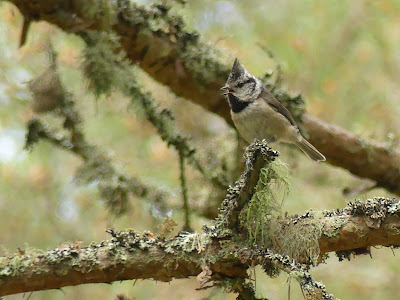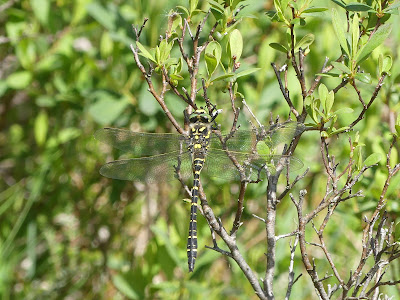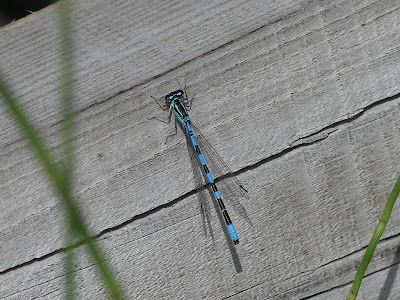Without the chance to travel from the UK through most of 2020 and 2021 to date, the opportunity to cross a border was taken, and we travelled to Scotland for a self catering week in a cottage and a few extra days to target specific damsel and dragonfly species as well further North-west.
25/26th June.
The trip started off with a chilly walk around Flanders Moss near Stirling where we broke the northward journey. Upon arrival late afternoon and again in the morning the following day, that produced very few Odonata due to the overcast conditions. A single Large Heath struggled to put an appearance in during the afternoon visit, with just a few Tree Pipits and a family party of Stonechats the next morning.
A stop at Killercrankie around the middle of the day was warm and bird activity was low, with apart from a very brief snatch of Wood Warbler song, none were seen, not any Redstart or Pied Flycatchers.
A diversion to Trinafour for a brief look for Black Grouse was not fruitful, but a Redstart and Spotted Flycatcher were seen, along with a Golden Ringed Dragonfly.
Golden Ringed Dragonfly
We cut back to the A9 across the moors and came across a small loch, Maud Loch which was explored, with just Common Blue and Large Red Damselflies being found, along with a Large Heath and Small Pear-bored Fritillary.
Small Pearl-boarded Fritillary
Large Heath
27th June.
Abernethy Forest was todays destination to visit the two pretty well known sites for Northern Damselfly and White-faced Darters. The first pool with the broad walk proved to be the best site visited for Northern's during the whole week, which whilst other sites all provided specimens, this was the only one where they were seen in any numbers. Other species seen were just six Four-spotted Chaser and a number of the ever present Large Red Damselflies.

Northern Damselfly
Four-spotted Chaser
A brief visit to the Osprey centre to discover they are absent again this year and the nest tree is empty, followed by a walk by Loch Garten to Loch Mallachie.
Several Crested Tits were seen in the woods along with a single Redstart. Loch Garten had a few Blue-tailed, Common Blue and as ever, Large Red Damselflies.
Crested Tit
As we headed towards Tulloch Moor to the White-faced Darter spot and the shortest broad walk I have ever been on, conveniently placed so they can be photographed without treading on the sensitive bog habitat. At least six White-faced Darters were present, a female Common Hawker dropped in to egg lay, along with the ever present Large Reds.
White faced Darter
Common Hawker
A visit to a Loch on Tulloch Moor produced over 200 Common Blue Damselflies, single mating pair of Northern Damselflies, six Four-spotted Chasers and a single White-faced Darter. A single Dark Green Fritillary whizzed by.
Common Blue Damselfly
Large Red Damselfly
Northern Damselfly
28th June
Craigellachie NNR was todays Northern Damselfly destination The lower Loch (Puladdern) had a few Damselflies with Common Blue, Blue-tailed, Large Red and a single Northern, together with sixteen Four-spotted Chasers. The upper loch (old reservoir) had twice as many Four-spotted Chasers with c 30, more Common Blue and Large Reds, no Northern, but a single Golden Ringed Dragonfly and a freshly emerging Common Hawker.
Four-spotted Chaser
Northern Damselfly
Golden Ringed Dragonfly

Common Hawker
Whilst wandering around the woods Tree Pipit and Pied Flycatcher were seen, along with again a brief snatch of Wood Warbler song, which again due to shortness failed to reveal the bird it's self. A few Small Pearl-boarded Fritillaries flitted around.
Tree Pipit
Pied flycatcher male
Small Pearl-boarded Fritillary
Leech in Loch Puladdern
Afterwards we headed up to Lochindorb, mainly to see the Black-throated Divers found there, but it seems to becoming a favourite recreation spot, but a single one asleep was found on the loch until someone paddled towards it in a canoe woke it up. A single Red Grouse was seen and the area had a few Large Heath and Small Pearl-boarded Fritillary with a single Dark Green seen again whizzing through. The loch only produced Common Blue and Large Red Damselflies.
Large Heath
Small Pearl-boarded Fritillary
Green-veined White
Red Grouse
29th June
The focus for toady was Anagach Wood at Grantown-on-spey. There was supposed to be a good Odonata area on the 'green' walk' and we found the area easily enough, but there were not a lot of water on the bog with the main bog being damp but not with any surface lying water, though there area few ponds by the track, which produced a few Four-spotted Chasers and a quite a few Large Red Damselflies, but nothing else.
Four-spotted Chaser
Newt in one of the few ponds
A single Pearl-boarded Fritillary was seen along with Crested Tit and Tree Pipit, with a Scottish Crossbill heard and not seen again.
Red Squirrel
Afterwards the plan was to visit the Revack estate that had a couple of ponds that Northern Damselfly have been seen at, but the estate was closed, though I managed to check the fishing pond by the A95/B970 junction without success just seeing Common Blue, Blue-tailed and Large Red Damselflies.
Blue-tailed Damselfly
As we had extra time so a quick check was made of the skating pond next to Grantown-on-Spey sewage works which only produced a Four-spotted Chaser. The are was not checked extensively though and there may have been some Northern Damselflies at the boggy northern end, but a lot of the pod side did not seem accessible in the potential better areas.
All three areas visited have previously reported records of Northern Damselflies.
A final walk along the river at Dulnain Bridge for Dipper gave use a female Goosander and young, but no Dipper alas. They proved hard to find, and this spring there was heavy snow fall into mid May, so where numbers lower than normal or were we just unlucky?
Goosander, female and two juvenile.
30th June.
Todays visiting locations were Milton Loch and a repeat visit to the Loch on Tulloch Moor. Milton give us our first Emerald Damselfly of the trip, plus three Northern, Blue-tailed, Common Blue and Large Red Damselflies, and a single Small Pearl-bordered Fritillary.
Common Blue Damselfly
Northern Damselfly
Emerald Damselfly
Small Pearl-bordered Fritillary
Tulloch Moor loch again produced small numbers of Northern Damselflies, only four seen, another Emerald Damselfly, a single White-faced Darter, up to 25 Four-spotted Chaser and 150 Common Blue Damselflies, a single Small Pearl-boarded Frantically, a couple of Dark Green Fritillary and Common Blue.
Four spotted Chaser
Northern Damselfly
Emerald Damselfly
White-faced Darter
Common Blue Damselfly
Common Blue
Afterwards a quick visit again Abernethy Forest to the White-faced Darters area and the main pond for Northern Damselflies again.
White-faced Darters
Northern Damselflies
1st July
Todays foray was to Uath Lochans. The walk took you pass several medium sized lochs with one that provided the main source of Odonata sightings. Spotted Flycatcher was seen, and again Scottish Crossbill only heard. Five Northern Damselflies were seen with 45 Common Blue and a couple of Blue-tailed, around 50 Large Red Damselflies, along with 10 Four-spotted Chasers, five White-faced Darters and a couple of Golden Ringed Dragonflies, and a single freshly emerged Common Hawker. A couple if Small Pearl-boarded Fritillaries passed by.
Utah Lochans
Water lilies at Utah Lochans
White-faced Darters
Large Red Damselfly
Blue-tailed Damselfly
Common Hawker
Golden Ringed Dragonfly
Afterwards in the heat of the afternoon, this whole week was reaching 20 by the middle of the day was spent looking for Northern Brown Argus at Insh Marshes, with four seen along with fifteen Small Pearl-bordered Fritillaries, a single Dark Green, along with a few other common species, and a couple of Four-spotted Chasers and Common Blue Damselflies.
Small Pearl-bordered Fritillary
Dark Green Fritillary
Northern Brown Argus
2nd July
Our final day in the Speyside area took us to Loch an Eilein, just to visit one of the final Speyside sites for Northern Damselfly. Bird wise it produced for the first time actual sighting of six Scottish Crossbill, Crested Tits and several Spotted Flycatchers. Dragonflies were not prolific here, but probably if we had added the walk around Loch Gamhna more might have been found. We did manage to find one single Northern Damselfy, four Common (Northern) Darter freshly emerged, five Golden Ringed Dragonflies, four Four-spotted Cahsers, and the usual Common Blue and Large Red Damselflies.
Spotted Flycatcher
Scottish Crossbill
Large Red Damselfly
Common (Northern) Darter
Golden Ringed Dragonfly
Northern Damselfly
The old outside toilet of the one the estates rental cottages by the Loch.
Having found a location on iRecord previously for Mountain Ringlet very close to a public road, speaking to someone the day before reminded me of the site and an overnight check of iRecord revealed in the heatwave some had already emerged, so head south to Trinafour. A short walk soon produced six Mountain Ringlets, ten Small Pearl-boarded and a single Dark Green Capillarity, and up to five Large Heaths. Denise stayed by the car rather than walk through the long boggy grass, and even had a Mountain Ringlet come up to the roadside. How many other sites for them could you see one on a roadside verge?
Large Heath
Mountain Ringlets
Afterwards we made a quick visit to the nearby Maud Loch which produce the only Azure Damselfly of the trip, a couple of Blue-tailed, numerous Large Red and several Common Blue Damselflies, a couple of Four-spotted Chasers and a Golden Ringed Dragonfly. A couple of Large Heaths were present, with three Small Pearl-boarded and a single Dark Green Fritillary.
Dark Green Fritillary
Golden Ringed Dragonfly
Azure Damselfly
Blue-tailed Damselfly
Speyside locations:
There is a very useful guide to Cairngorm/Speyside dragonflies that can be found at:
There are many other maps of local walks and woodland paths to be found utilising web searches.
The Abernethy Forest/Loch Garten locations are:
1. Northern damselfly - the small loch next to the road from Loch Garten with an obvious boardwalk into the loch.
2. Northern Emerald and White-faced Darter - about half way between the Osprey centre and the Tulloch right turn, the road bends obviously to the left and on the right there is a pull off, with branches across the track that comes off here to prevent further vehicular access down it. Stop here and walk down the track on the right covered by the branches. After about 10 minutes you will pass through a gate in a fence to kore open boggier habitat. Walk a further 5 minutes and there is a low lying area with planks laid over a boggy area before a fence.
3. White-faced Darter - the road from the Osprey centre dips just before the right turn to Tulloch. In the dip on the right there is a dirt area byside the road that will allow a couple of car to pull over. Walk right into the forest, there should be a slightly obvious path, going only a few metres, where you will find the smallest boardwalk ever, about 3 metres in length protecting the small boggy area frequented by the White-faced Darters.














































































